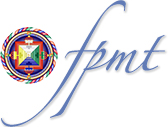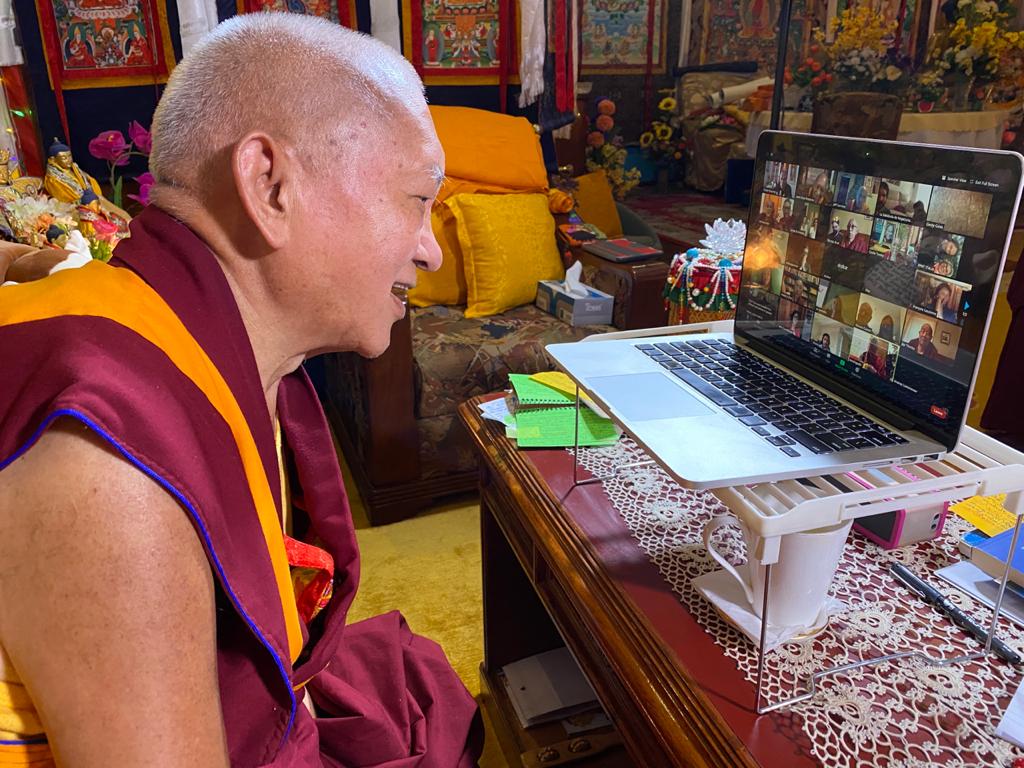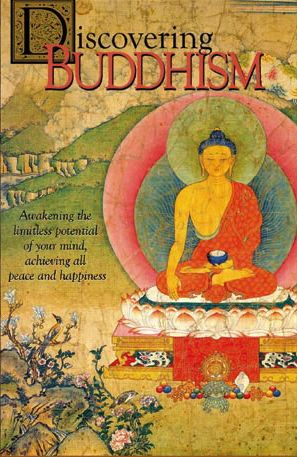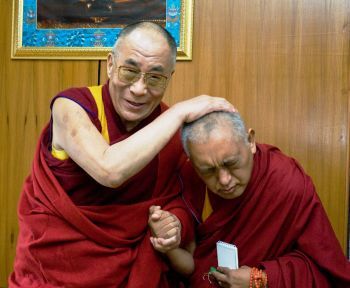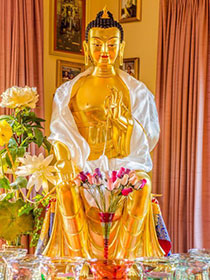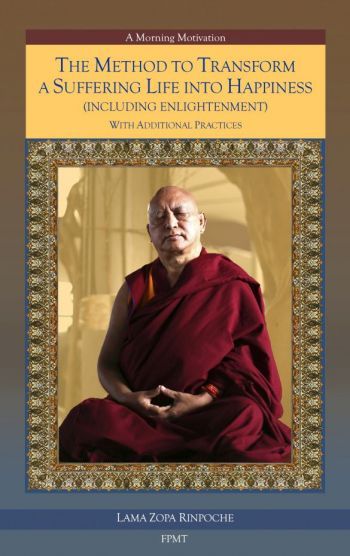- Home
- FPMT Homepage
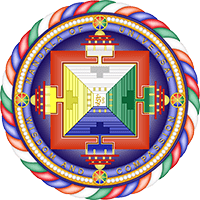
Foundation for the Preservation of the Mahayana Tradition
The FPMT is an organization devoted to preserving and spreading Mahayana Buddhism worldwide by creating opportunities to listen, reflect, meditate, practice and actualize the unmistaken teachings of the Buddha and based on that experience spreading the Dharma to sentient beings. We provide integrated education through which people’s minds and hearts can be transformed into their highest potential for the benefit of others, inspired by an attitude of universal responsibility and service. We are committed to creating harmonious environments and helping all beings develop their full potential of infinite wisdom and compassion. Our organization is based on the Buddhist tradition of Lama Tsongkhapa of Tibet as taught to us by our founders Lama Thubten Yeshe and Lama Thubten Zopa Rinpoche.
- Willkommen
Die Stiftung zur Erhaltung der Mahayana Tradition (FPMT) ist eine Organisation, die sich weltweit für die Erhaltung und Verbreitung des Mahayana-Buddhismus einsetzt, indem sie Möglichkeiten schafft, den makellosen Lehren des Buddha zuzuhören, über sie zur reflektieren und zu meditieren und auf der Grundlage dieser Erfahrung das Dharma unter den Lebewesen zu verbreiten.
Wir bieten integrierte Schulungswege an, durch denen der Geist und das Herz der Menschen in ihr höchstes Potential verwandelt werden zum Wohl der anderen – inspiriert durch eine Haltung der universellen Verantwortung und dem Wunsch zu dienen. Wir haben uns verpflichtet, harmonische Umgebungen zu schaffen und allen Wesen zu helfen, ihr volles Potenzial unendlicher Weisheit und grenzenlosen Mitgefühls zu verwirklichen.
Unsere Organisation basiert auf der buddhistischen Tradition von Lama Tsongkhapa von Tibet, so wie sie uns von unseren Gründern Lama Thubten Yeshe und Lama Thubten Zopa Rinpoche gelehrt wird.
- Bienvenidos
La Fundación para la preservación de la tradición Mahayana (FPMT) es una organización que se dedica a preservar y difundir el budismo Mahayana en todo el mundo, creando oportunidades para escuchar, reflexionar, meditar, practicar y actualizar las enseñanzas inconfundibles de Buda y en base a esa experiencia difundir el Dharma a los seres.
Proporcionamos una educación integrada a través de la cual las mentes y los corazones de las personas se pueden transformar en su mayor potencial para el beneficio de los demás, inspirados por una actitud de responsabilidad y servicio universales. Estamos comprometidos a crear ambientes armoniosos y ayudar a todos los seres a desarrollar todo su potencial de infinita sabiduría y compasión.
Nuestra organización se basa en la tradición budista de Lama Tsongkhapa del Tíbet como nos lo enseñaron nuestros fundadores Lama Thubten Yeshe y Lama Zopa Rinpoche.
A continuación puede ver una lista de los centros y sus páginas web en su lengua preferida.
- Bienvenue
L’organisation de la FPMT a pour vocation la préservation et la diffusion du bouddhisme du mahayana dans le monde entier. Elle offre l’opportunité d’écouter, de réfléchir, de méditer, de pratiquer et de réaliser les enseignements excellents du Bouddha, pour ensuite transmettre le Dharma à tous les êtres. Nous proposons une formation intégrée grâce à laquelle le cœur et l’esprit de chacun peuvent accomplir leur potentiel le plus élevé pour le bien d’autrui, inspirés par le sens du service et une responsabilité universelle. Nous nous engageons à créer un environnement harmonieux et à aider tous les êtres à épanouir leur potentiel illimité de compassion et de sagesse. Notre organisation s’appuie sur la tradition guéloukpa de Lama Tsongkhapa du Tibet, telle qu’elle a été enseignée par nos fondateurs Lama Thoubtèn Yéshé et Lama Zopa Rinpoché.
Visitez le site de notre Editions Mahayana pour les traductions, conseils et nouvelles du Bureau international en français.
Voici une liste de centres et de leurs sites dans votre langue préférée
- Benvenuto
L’FPMT è un organizzazione il cui scopo è preservare e diffondere il Buddhismo Mahayana nel mondo, creando occasioni di ascolto, riflessione, meditazione e pratica dei perfetti insegnamenti del Buddha, al fine di attualizzare e diffondere il Dharma fra tutti gli esseri senzienti.
Offriamo un’educazione integrata, che può trasformare la mente e i cuori delle persone nel loro massimo potenziale, per il beneficio di tutti gli esseri, ispirati da un’attitudine di responsabilità universale e di servizio.
Il nostro obiettivo è quello di creare contesti armoniosi e aiutare tutti gli esseri a sviluppare in modo completo le proprie potenzialità di infinita saggezza e compassione.
La nostra organizzazione si basa sulla tradizione buddhista di Lama Tsongkhapa del Tibet, così come ci è stata insegnata dai nostri fondatori Lama Thubten Yeshe e Lama Zopa Rinpoche.
Di seguito potete trovare un elenco dei centri e dei loro siti nella lingua da voi prescelta.
- 欢迎 / 歡迎
简体中文
“护持大乘法脉基金会”( 英文简称:FPMT。全名:Foundation for the Preservation of the Mahayana Tradition) 是一个致力于护持和弘扬大乘佛法的国际佛教组织。我们提供听闻,思维,禅修,修行和实证佛陀无误教法的机会,以便让一切众生都能够享受佛法的指引和滋润。
我们全力创造和谐融洽的环境, 为人们提供解行并重的完整佛法教育,以便启发内在的环宇悲心及责任心,并开发内心所蕴藏的巨大潜能 — 无限的智慧与悲心 — 以便利益和服务一切有情。
FPMT的创办人是图腾耶喜喇嘛和喇嘛梭巴仁波切。我们所修习的是由两位上师所教导的,西藏喀巴大师的佛法传承。
繁體中文
護持大乘法脈基金會”( 英文簡稱:FPMT。全名:Found
ation for the Preservation of the Mahayana Tradition ) 是一個致力於護持和弘揚大乘佛法的國際佛教組織。我們提供聽聞, 思維,禪修,修行和實證佛陀無誤教法的機會,以便讓一切眾生都能 夠享受佛法的指引和滋潤。 我們全力創造和諧融洽的環境,
為人們提供解行並重的完整佛法教育,以便啟發內在的環宇悲心及責 任心,並開發內心所蘊藏的巨大潛能 — 無限的智慧與悲心 – – 以便利益和服務一切有情。 FPMT的創辦人是圖騰耶喜喇嘛和喇嘛梭巴仁波切。
我們所修習的是由兩位上師所教導的,西藏喀巴大師的佛法傳承。 察看道场信息:
- FPMT Homepage
- News/Media
-
- Study & Practice
-
-
- About FPMT Education Services
- Latest News
- Programs
- New to Buddhism?
- Buddhist Mind Science: Activating Your Potential
- Heart Advice for Death and Dying
- Discovering Buddhism
- Living in the Path
- Exploring Buddhism
- FPMT Basic Program
- FPMT Masters Program
- FPMT In-Depth Meditation Training
- Maitripa College
- Lotsawa Rinchen Zangpo Translator Program
- Universal Education for Compassion & Wisdom
- Online Learning Center
-
- Prayers & Practice Materials
- Overview of Prayers & Practices
- Full Catalogue of Prayers & Practice Materials
- Explore Popular Topics
- Benefiting Animals
- Chenrezig Resources
- Death & Dying Resources
- Lama Chopa (Guru Puja)
- Lama Zopa Rinpoche: Compendium of Precious Instructions
- Lama Zopa Rinpoche: Life Practice Advice
- Lama Zopa Rinpoche Practice Series
- Lamrim Resources
- Mantras
- Prayer Book Updates
- Purification Practices
- Sutras
- Thought Transformation (Lojong)
- Audio Materials
- Dharma Dates - Tibetan Calendar
- Translation Services
- Publishing Services
- Ways to Offer Support
- Prayers & Practice Materials
-
- Teachings and Advice
- Find Teachings and Advice
- Lama Zopa Rinpoche Advice Page
- Lama Zopa Rinpoche: Compendium of Precious Instructions
- Lama Zopa Rinpoche Video Teachings
- ༧སྐྱབས་རྗེ་བཟོད་པ་རིན་པོ་ཆེ་མཆོག་ནས་སྩལ་བའི་བཀའ་སློབ་བརྙན་འཕྲིན།
- Podcasts
- Lama Yeshe Wisdom Archive
- Buddhism FAQ
- Dharma for Young People
- Resources on Holy Objects
- Teachings and Advice
-
-
*If a menu item has a submenu clicking once will expand the menu clicking twice will open the page.
-
-
- Centers
-
- Teachers
-
- Projects
-
-
-
-
*If a menu item has a submenu clicking once will expand the menu clicking twice will open the page.
-
-
- FPMT
-
-
-
-
-
I encourage people not to express their anger, not to let it out. Instead, I have people try to understand why they get angry, what causes it and how it arises. When you realize these things, instead of manifesting externally, your anger digests itself. In the West, some people believe that you get rid of your anger by expressing it, that you finish it by letting it out. Actually, in this case what happens is that you leave an imprint in your mind to get angry again.
Lama Thubten Yeshe
-
-
-
- Shop
-
-
-
The Foundation Store is FPMT’s online shop and features a vast selection of Buddhist study and practice materials written or recommended by our lineage gurus. These items include homestudy programs, prayers and practices in PDF or eBook format, materials for children, and other resources to support practitioners.
Items displayed in the shop are made available for Dharma practice and educational purposes, and never for the purpose of profiting from their sale. Please read FPMT Foundation Store Policy Regarding Dharma Items for more information.
-
-
A Personal Account of a Visit to Tsum
Tsum – the blessed valley
Ani Fran Mohoupt
The trip to Tsum was really, really wonderful. Tsum just felt like home. I know that sounds strange and probably many people talk like that, just blah blah. For me, arriving in Tsum and jumping out of the helicopter was like coming home.
This was a very powerful experience for me. And it was so incredible to see all the places I had talked about to various people in preparation for the project over this past year.
The Tsum valley is truly beautiful, a long valley, with the pathways lined with stupas and mani walls, the mountains dotted with the holy places of Milarepa and Guru Rinpoche, and the caves of yogis and yoginis who have achieved realizations in this valley for many hundreds of years.
The atmosphere is imbued with spiritual energy: the wish for Dharma practice comes nearly naturally, effortlessly – an amazing and transforming experience.
For the first few days we were staying at Rachen Nunnery, which is right in the center of the valley. We were very fortunate with the weather – not too cold, not too hot. Nighttimes a warm sleeping bag was in order. What it would be like in winter is hard to imagine.
The nuns at Rachen Gompa are so sweet; there are many young ones, and a very impressive group of older nuns that have done retreat and have a lot of knowledge. We attended a guru puja at Rachen Nunnery with all the nuns. The puja lasted for seven hours and I have to admit we all started to squirm on our seats a bit, while the nuns were sitting unperturbed, beautifully concentrating on the prayers. There was much laughter afterwards as we staggered out of the gompa with stiff legs.

From Rachen Nunnery we made a number of excursions in the valley, walking every day. It was sometimes quite tiring, with getting used to the altitude and the unaccustomed exercise. I am not fit at all, your proverbial couch potato. However the inspiring environment made up for all of it. Gelek Gyatso stayed in the lama room at Rachen, decorated with very beautifully painted murals, whereas the rest of the group stayed in the guest rooms.
Although living conditions are very tough at Rachen and Mu, one of the delightful things that the nuns and also the monks have created for themselves are the beautiful little private courtyards which provide shelter from the constant wind and trap the warmth of the sun, making it the perfect place for growing some flowers and vegetables, a welcome addition for their otherwise simple meals. Going from the courtyard to the outside area was like going under a cold shower – out comes the coat and the hat.
We visited Mu Gompa, a very a long walk of 7 hours for us, (the local Tsumpas do it in 4 hours). Mu Gompa was absolutely fantastic – everything you dream of when you image a remote monastery in a rugged valley. The monastery is built on a steep slope of a mountain. Again, it felt very familiar, specially the little house above the monastery where we stayed. Geshe Chokley, the resident teacher of both Rachen Nunnery and Mu Gompa, and the monks at Mu took excellent care of us.
We offered toothpaste, toothbrushes and soap to all the Sangha, and Frances and Chodak gave everyone a hygiene talk, which had everyone in stitches.
On the last two days we went for the longest and most beautiful walk along the mountain ridge far above the villages visiting all of Geshe Lama Konchog’s holy places. It was really very moving to know this is where Geshe-la had meditated, where he did his practices, to see his cave, the small little house where he did his main retreat. The house was not in good repair, but a beautiful wild red climbing rose was in full bloom covering the house and garden.
During the ten days of our stay, we did a health survey of people at the monastery, nunnery and in various villages. Frances Howland, a nurse who works in Kathmandu, accompanied us. She organized the survey and held a clinic each day in the nunnery courtyard with Ven. Chodak, the head master of the school at Kopan, interpreting for her.
Interviewing people for the health survey was a real eye-opener to all of us about the poor conditions that people live in – there were always many people coming to see Frances; wherever we stopped there was a bunch of people already waiting as they had heard we were on the way. It made our progress very slow, but Frances could help many people even with thelimited medicine that we had brought with us.
We saw quite a few babies whose mothers had died in childbirth; there were even two sets of twins whose mother had died, leaving the father all alone to take care of them. Not an easy task.
Many people had eye problems, mainly from working in smoky kitchens. Many old people were blind from cataracts. There was really nothing we could do for them as they needed surgery. Cataracts are very common due to the high ultraviolet light exposure. Being blind or of poor eyesight is pretty terrible there as it means you can’t go anywhere by yourself.
Gelek Gyatso Rinpoche suggested that organizing an eye camp would be very helpful for the local people. After approaching a leading eye hospital in Kathmandu, we now have a commitment from them to do an eye camp with cataract removal and lens implant early next year. Already more than 60 people have been identified as recipient for the lens implants.
Tsum remains an impression not just in the memory, but in the heart. From Kopan I look at Himal Ganesh, the snow mountain behind which the Tsum valley is hidden, and I am instantly transported back there, the smell of the wild garlic that the nuns collected, the constant roar of the wind, the hermitage clinging to the side of the mountain like a bird’s nest, and the smile of people living there.
How Can I Make a Donation?
Any amount of donation is welcome. To make a donation simply send your check in US dollars to FPMT Inc. and write Tsum on the check or provide your credit card details and mail to:
|
|
Your donation will go towards supporting the following activities
|
FPMT has established Tsum (TSUM) as a designated purpose fund, which with the support of generous benefactors, supports the work of FPMT’s affiliate, Tsum (TSUM). All donations made to the fund are tax-deductible to the extent allowed by law.
- Tagged: other projects
- Home
- News/Media
- Study & Practice
- About FPMT Education Services
- Latest News
- Programs
- New to Buddhism?
- Buddhist Mind Science: Activating Your Potential
- Heart Advice for Death and Dying
- Discovering Buddhism
- Living in the Path
- Exploring Buddhism
- FPMT Basic Program
- FPMT Masters Program
- FPMT In-Depth Meditation Training
- Maitripa College
- Lotsawa Rinchen Zangpo Translator Program
- Universal Education for Compassion & Wisdom
- Online Learning Center
- Prayers & Practice Materials
- Overview of Prayers & Practices
- Full Catalogue of Prayers & Practice Materials
- Explore Popular Topics
- Benefiting Animals
- Chenrezig Resources
- Death & Dying Resources
- Lama Chopa (Guru Puja)
- Lama Zopa Rinpoche: Compendium of Precious Instructions
- Lama Zopa Rinpoche: Life Practice Advice
- Lama Zopa Rinpoche Practice Series
- Lamrim Resources
- Mantras
- Prayer Book Updates
- Purification Practices
- Sutras
- Thought Transformation (Lojong)
- Audio Materials
- Dharma Dates – Tibetan Calendar
- Translation Services
- Publishing Services
- Teachings and Advice
- Find Teachings and Advice
- Lama Zopa Rinpoche Advice Page
- Lama Zopa Rinpoche: Compendium of Precious Instructions
- Lama Zopa Rinpoche Video Teachings
- ༧སྐྱབས་རྗེ་བཟོད་པ་རིན་པོ་ཆེ་མཆོག་ནས་སྩལ་བའི་བཀའ་སློབ་བརྙན་འཕྲིན།
- Podcasts
- Lama Yeshe Wisdom Archive
- Buddhism FAQ
- Dharma for Young People
- Resources on Holy Objects
- Ways to Offer Support
- Centers
- Teachers
- Projects
- Charitable Projects
- Make a Donation
- Applying for Grants
- News about Projects
- Other Projects within FPMT
- Support International Office
- Projects Photo Galleries
- Give Where Most Needed
- FPMT
- Shop
Translate*
*powered by Google TranslateTranslation of pages on fpmt.org is performed by Google Translate, a third party service which FPMT has no control over. The service provides automated computer translations that are only an approximation of the websites' original content. The translations should not be considered exact and only used as a rough guide.No desire means no emotional pain of attachment, anger and jealousy. There is peace, openness and space for genuine love and compassion to arise.
